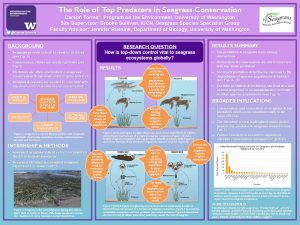The Role of Top Predators in Seagrass Conservation
There is a growing need for conservation and restoration efforts to sustain seagrass — an aquatic plant that provides many vital ecosystem services — as their populations are declining globally. The aim of this study was to gain a greater insight into how top-down control affects seagrass meadow populations. Top-down control is the interactions between top predators and lower trophic level species. My internship consisted of assessing the risk of extinction that seagrass species are facing in bioregion 6 (mainly New Zealand and the southern region of Australia), and recording seagrass sighting locations and population trends. I conducted a literature review of ten scientific papers that specifically looked at top-down control in seagrass ecosystems across the globe. The research papers I examined mainly focused on seagrass ecosystems along the west coast of the United States and Canada, as well as the coastlines of Australia. All of the papers shared a common finding — predator population flux affected seagrass meadow populations in both positive and negative ways. These results are important because in order for seagrass restoration and conservation to be effective there must simultaneously be efforts to sustain predator populations as well. Currently, there is a lack of funding and research efforts pertaining to top-down control in seagrass ecosystems. There is also a lack of discourse and management implementation of top-down control in seagrass conservation — these findings highlight the urgency to do so.
